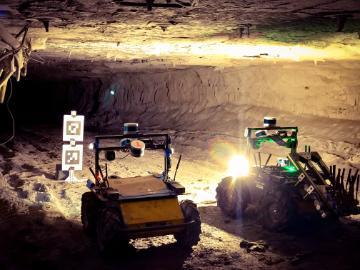Going Deep

Enabling a group of autonomous aerial and ground robots to work together to explore perceptually degraded, unstructured and GPS-denied environments is what gets electrical engineering Ph.D. candidate Kamak Ebadi out of bed every morning. His groundbreaking research—a collaborative simultaneous localization and mapping (SLAM) algorithm for multi-robot exploration of exactly those types of environments—has taken him to great heights and is now plunging him to great depths. Initially developed for exploring Mars with a first-of-its-kind helicopter and rover team, his work is now being used in harsh and challenging environments 900 feet below the Earth’s surface.
As a doctoral research fellow at NASA Jet Propulsion Laboratory, Kamak was selected to join NASA JPL’s CoSTAR (Collaborative SubTerranean Autonomous Robots) team for the prestigious DARPA Subterranean Challenge. Previous DARPA challenges led to breakthroughs for the internet, autonomous cars, and drones.
Team CoSTAR is made up of 60 technologists, researchers and engineers from 4 institutions—NASA JPL, Caltech, MIT, and KAIST (formerly the Korea Advanced Institute of Science and Technology) who are developing autonomous, collaborative subterranean robots for competition in DARPA’s 3-year, multi-contest challenge. Only 20 members of each team may actually compete in the on-site challenges, and Kamak made the cut.
The first contest, held in August, was the Tunnel Circuit competition, held in Pittsburgh’s formerly operational coal mining tunnels. For this competition, CoSTAR created a fleet of drones and wheeled and tracked robots that worked together using cutting-edge autonomy solutions to independently explore and map the warren of complex and challenging underground pathways and locate a variety of objects. Backpacks, cellphones and survivors (mannequins) were hidden throughout the course to replicate a real search and rescue scenario.
Kamak’s collaborative SLAM solution, developed in partnership with JPL and MIT, helped the CoSTAR team win 2nd Place in the competition! Kamak is the lead author on a paper describing the breaking results of this solution submitted to the IEEE International Conference on Robotics and Automation (ICRA 2020), one of the largest and most prestigious robotics conferences in the world.
While using futuristic robots to find hidden treasure may seem like fun and games, DARPA created the challenge with the very serious purpose of advancing technology for defense and first responders operating in challenging underground environments. Finding solutions to the problems of troublesome access, GPS-denied, unpredictable terrain, limited visibility, and poor communication offers immediate benefit to disaster relief agencies, but also opens the possibility of addressing rising urban populations by building down, rather than up.
Today the competition focuses on applications here on Earth, but this research provides unparalleled scientific opportunities and lays the groundwork for future robotic exploration of caves and lava tubes on the moon, Mars, and beyond that could one day provide a safe habitat for future human space missions.
More: https://www.darpa.mil/program/darpa-subterranean-challenge